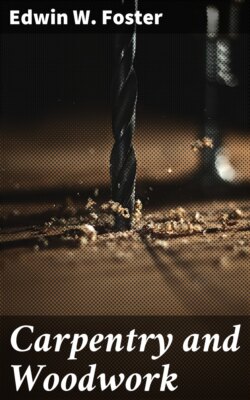Читать книгу Carpentry and Woodwork - Edwin W. Foster - Страница 7
На сайте Литреса книга снята с продажи.
ОглавлениеFig. 12. Second calendar back
After two or three of these had been made, Harry decided that they were too small to suit him, and a new design somewhat larger was worked out on paper. It was a little more difficult to follow, because the outline had two reversed curves, but the boys were too busy and interested to be daunted by a trifle like that. (Fig. 12.)
Ralph suggested simple picture frames, and this brought the new problem of cutting out an opening for the picture.
Fig. 13. Picture frame with elliptical opening
The first design they tried is shown in Fig. 13. Ralph had to show Harry how to make the ellipse with compasses by first constructing two squares or rectangles touching, and with both diagonal lines in each square. By taking for a centre the point where the squares touch, as a and b, and using the length of a diagonal line as a radius, two arcs were drawn at x and y. The ellipse was finished by taking c as a centre, and the distance c d as a radius, to draw arc z, and the other end was finished in the same way.
Ralph explained that this was not a perfect ellipse, but would answer for a small picture frame. The drawing was easy compared to the question of how to cut out the wood to this curved line.
Fig. 14. Using the coping saw
One of the new tools was brought out, and Harry was introduced to the mysteries of the coping saw. (Fig. 14). A thin saw blade was produced and fastened in one end of the frame, the other end being left free. A hole was made inside of the ellipse with a brad awl, the free end of the blade passed through the opening and fastened in the frame of the saw. Resting the picture frame on the edge of a bench, the ellipse was sawed out roughly about 1⁄16 of an inch inside of the drawing. This remaining sixteenth of an inch was then whittled to the line with a knife and finished with sand-paper. Harry found some difficulty in getting this elliptical opening smooth enough to suit him, so they tried designing for half an hour, and produced a new form (Fig. 15).
Fig. 15. Picture frame in straight lines
This was easier, as there were no curved lines, and it could be sawed close to the outside as well as the inside lines, to save time in whittling. While Harry was finishing this frame, Ralph was busy on a new design and finally passed over the drawing shown in Fig. 16.
Fig. 16. Third picture frame
"Do you know there is as much fun in getting up new designs as there is in making them in wood?" said Ralph.
"Yes, but you have to know how to draw," replied the younger boy. "Can't you teach me?"
"Yes. I first make a rough sketch of my idea, and then a careful drawing of its actual size, with the drawing instruments."
"That's the part that I want to learn: how to use the instruments."
A lesson in mechanical drawing followed, and as it is a very important subject to young woodworkers, it will be given in full in the next chapter.
